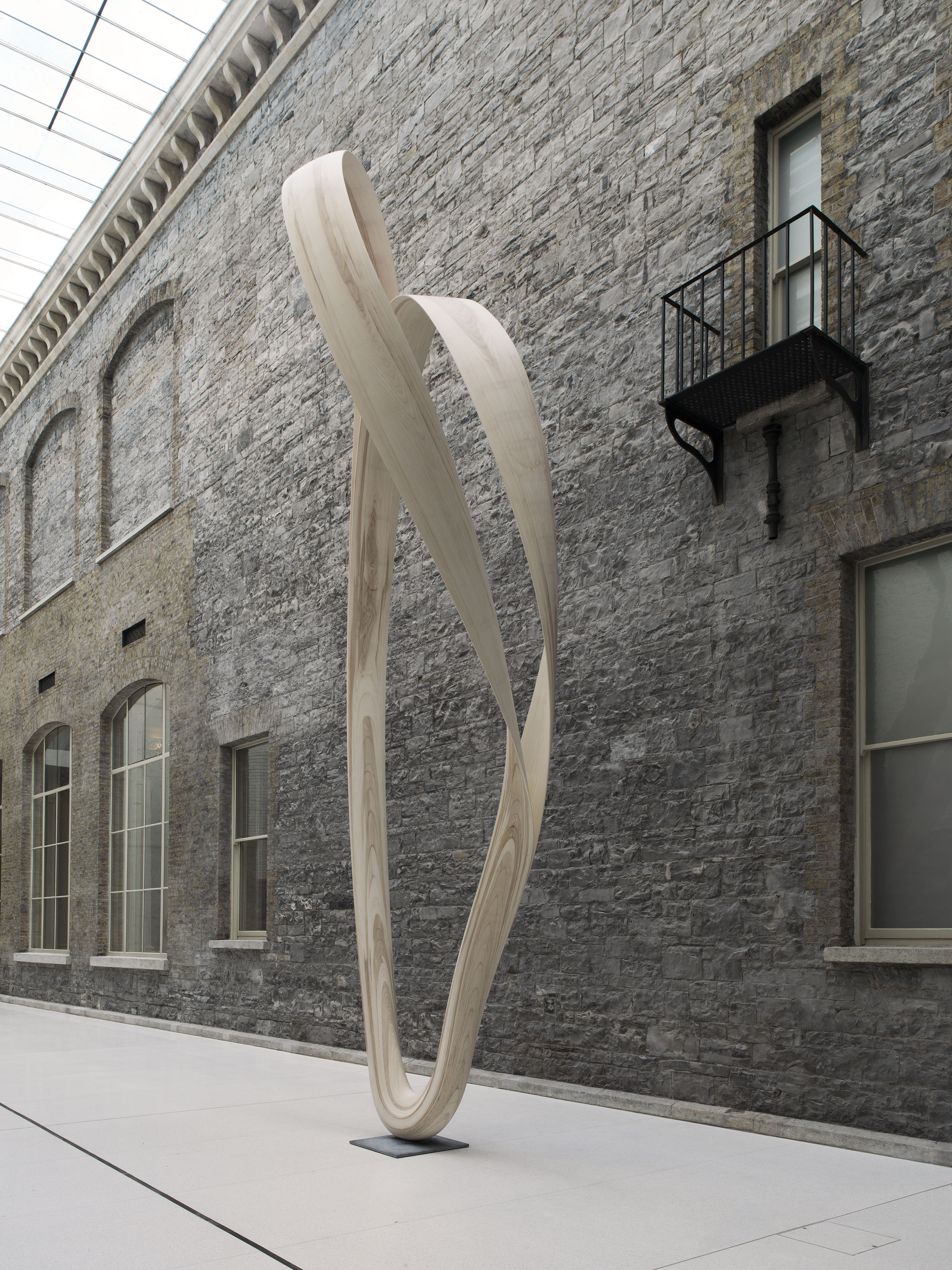 Joseph Walsh, Magnus Modus. © Joseph Walsh. Commissioned by the Office of Public Works on behalf of the National Gallery of Ireland under the Per Cent for Art Scheme Photo © National Gallery of Ireland
Joseph Walsh, Magnus Modus. © Joseph Walsh. Commissioned by the Office of Public Works on behalf of the National Gallery of Ireland under the Per Cent for Art Scheme Photo © National Gallery of Ireland

Online self-guided tour
Discover the historical and innovative techniques used in the practice of sculpture. Sampling a selection of sculptural works from the Gallery’s collection, you will learn about the unique approaches, theories and methods specific to this diverse discipline.
Finding your way around
- If you are doing this tour onsite at the Gallery, taking in all the works will take approximately 60 minutes.
- The works are listed in the order they appear in the Gallery if you enter from Merrion Square.
- Feel free to skip a few or spend longer at others.
- When in the Gallery, please be aware that you will be moving across various levels, which may require access to lifts. You can ask any member of staff to direct you to the closest lift.
- They will also be able to direct you to any other facilities you may require including a Changing Places facility located close to the Merrion Square entrance.
"The sculptor must search with passionate intensity for the underlying principle of the organisation of mass and tension - the meaning of gesture and the structure of rhythm." - Barbara Hepworth, A Pictorial Autobiography (ed. 1978).
Start the tour!
 Joseph Walsh, Magnus Modus. © Joseph Walsh. Commissioned by the Office of Public Works on behalf of the National Gallery of Ireland under the Per Cent for Art Scheme Photo © National Gallery of Ireland
Joseph Walsh, Magnus Modus. © Joseph Walsh. Commissioned by the Office of Public Works on behalf of the National Gallery of Ireland under the Per Cent for Art Scheme Photo © National Gallery of Ireland
The Courtyard
Joseph Walsh (b.1979), Magnus Modus, 2017
Designed in 2017, this large-scale sculpture was the winning proposal for a site-specific artwork funded by the Irish Government’s Per Cent for Art scheme. Titled Magnus Modus, the work was created by the internationally acclaimed Irish artist, designer and furniture maker Joseph Walsh. Magnus, the Latin word for large or great, is the title of a series of sculptures developed by Walsh. They represent the grand and impactful presence of these large-scale sculptures. Magnus Modus, featured here in the Gallery courtyard, is the very first continuous closed sculptural form in the Magnus series. A continuous closed sculpture is an unbroken form or shape that has no beginning or end.
The experience of the Gallery visitor was carefully considered by Walsh during the design process. While some sculpture can be static in nature, Magnus Modus has a sense of flow and movement captured through its continuous curved form, which encourages you to move around and within the work. The sculpture is made from olive ash wood, with a white oil finish. Olive ash is not a specific variety of ash, but rather a reference to the colour variation and streaks in the wood grain. It is the name given to the veneer cut from the dark heartwood or centre of the tree, typically found in European ash trees. The term veneer in woodworking refers to thin slices of wood that are glued to a coarser wood. The sculpture has a subtle softness, creating delicate shadows and light throughout the courtyard, altering your sense of space and scale.
- How does the sculpture in the space make you feel?
- Take some time to sit in this room and be mindful of the space around you.
Explore further
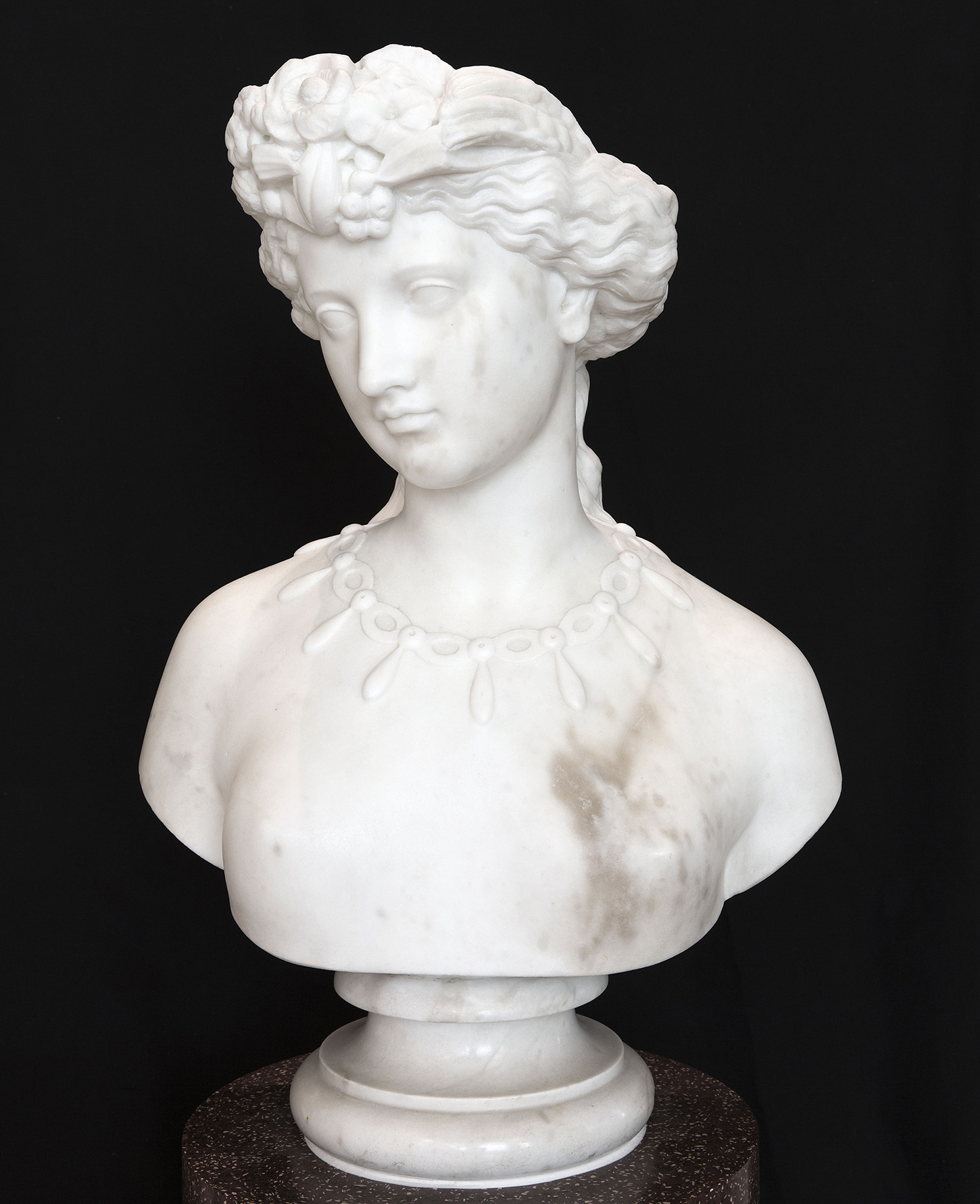
The Shaw Room
John Lawlor (1820-1901), A Young Girl, 1869
Irish sculptor John Lawlor created this scultpure of a young girl in 1869, adopting a traditional approach to the sculptural bust. A sculptural bust is a sculpted form or cast which represents the upper part of the human figure. This includes the person's head and neck, while also featuring a portion of the chest and shoulders. As seen here, these sculptural busts are typically supported by a plinth. Traditionally speaking, the bust is intended as a portrait, documenting the appearance or the likeness of a person. The medium used by Lawlor in this piece is marble, however sculptural busts can be made from a variety of media, from plaster to bronze, and even wax.
Sculptures that captured female beauty and embodied poetic connotations were highly sought-after by wealthy Victorian art collectors. Lawlor’s work included many romantic pieces like this, but also a number of large-scale public works of various subjects and individuals. During his time, women in art were often represented as passive objects whose main purpose was to look beautiful and desirable.
- Do you think the representation of women in art has changed since then?
- What kind of representations of femininity do we see in today’s world?
Explore further
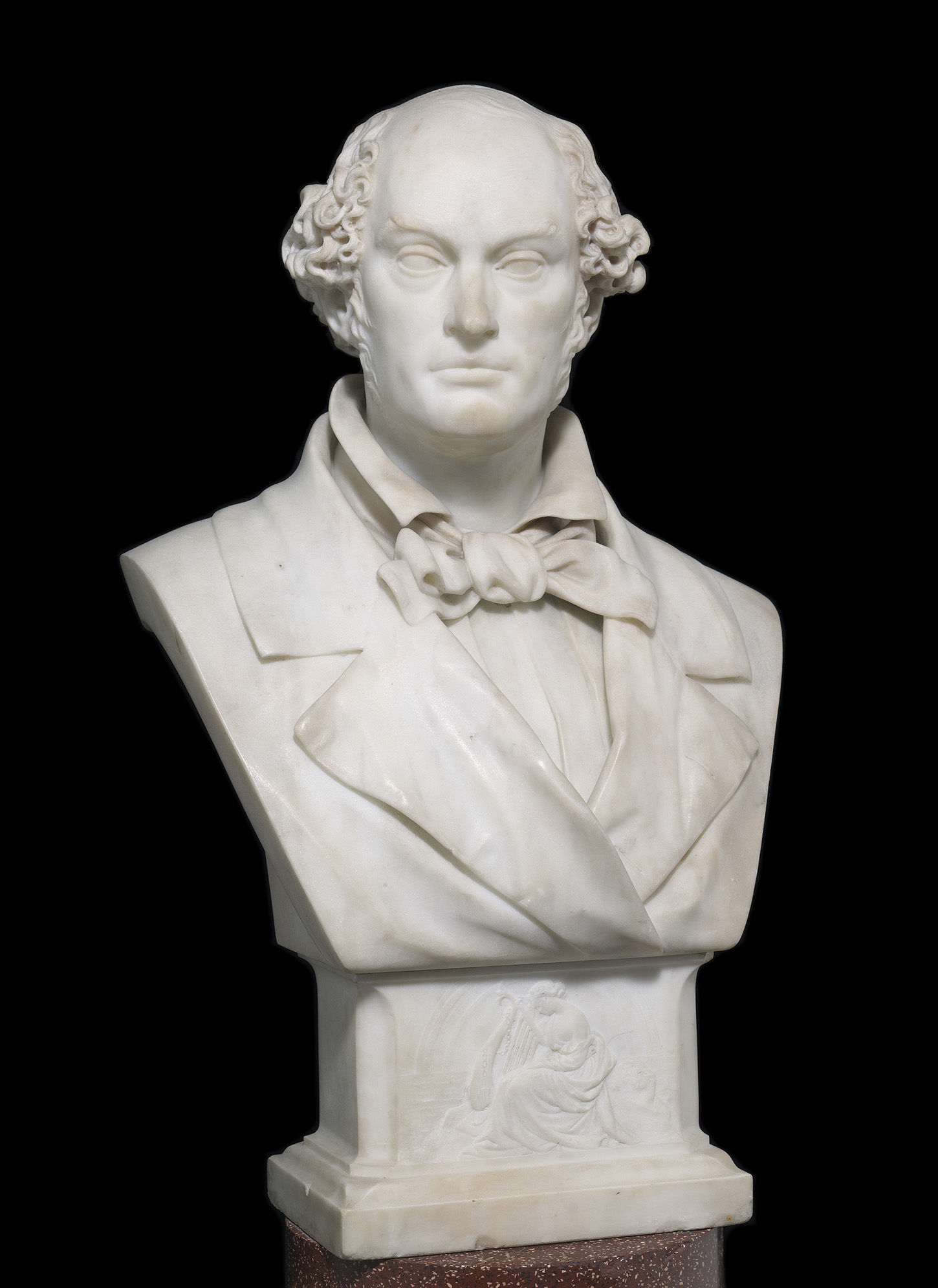
The Shaw Room
John Thomas (1813-1862), Daniel Maclise (1806-1870), Artist (above a relief of Hibernia), 1859
Here we see a sculptural bust of the acclaimed Irish artist, Daniel Maclise. He moved from his native Cork to London in 1827 and soon established himself as an accomplished portrait artist and illustrator. However, it was for his large scale historical paintings that Maclise gained much recognition, most notably The Marriage of Strongbow and Aoife (1854), which hangs opposite this bust.
This marble bust was created by British sculptor and architect John Thomas in 1859. Thomas, who most notably worked on Buckingham Palace and the Palace of Westminster, initially started out as a stone and wood carver. He soon focused only on stone carving and at the young age of 28, he was appointed a Supervising Carver at the Palace of Westminster, London, and later gained many other public commissions.
The role of Supervising Carver was a highly esteemed position, and Thomas was responsible for all of the sculptural figures of the historic monarchy of the English Kings and Queens. The position acknowledged his extensive skillset and industry knowledge, a crucial part of the requirements of a Supervising Carver.
- How long do you think it would take to learn the art of stone carving?
- Would you ever try it?
Explore further
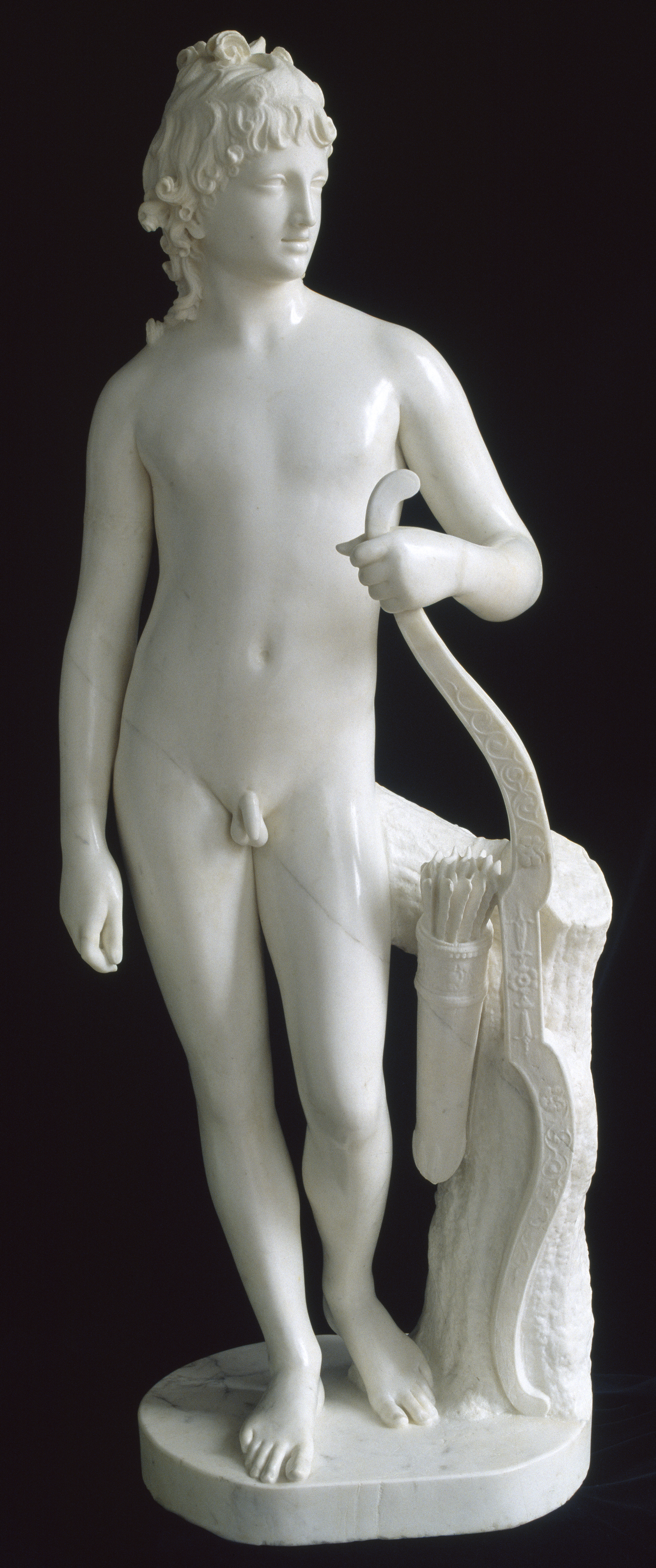 Antonio Canova (1757-1822), 'Amorino', 1789-1791. © National Gallery of Ireland.
Antonio Canova (1757-1822), 'Amorino', 1789-1791. © National Gallery of Ireland.
The Grand Gallery
Antonio Canova (1757-1822), Amorino, 1789-1791
Antonio Canova was a master of Neoclassical sculpture, never directly copying but instead creating his own versions of works inspired by his Roman and Greek predecessors. During the 18th century, there was a renewed interest in classical antiquity as a result of new archaeological discoveries, in particular the excavation of the Roman cities of Pompeii and Herculaneum. Artists had greater access to classical sculptures in private collections and museums, and this had a huge impact on 18th century sculpture.
In the creation of this work, Canova adopted a technique called pointing. This method involved blocking out sections of marble using specific measurements. These measurements were taken from bronze screws that were embedded into the form using a compass. This technique enabled Canova to work with much greater precision, allowing him to produce multiple marble forms using the exact same measurements.
Amorino, the subject of this work, is also known as Cupid, the son of Venus, the Roman goddess who represents love, desire, beauty and prosperity. This sculpture was one of four versions created by Canova using the pointing technique. Here we see Cupid standing with a bow by his side. His pose was influenced by the statue of Doryphoros. The figure depicts a strong, muscular male form, holding a spear down by his left side. Doryphoros was a very influential sculpture as it illustrated the novel methods of depicting the human form developed by the Greeks during the Classical Period using techniques like contrapposto, which we will discuss in more detail later.
- What does this sculpture tell us about the culture and time period in which it was created?
Explore further
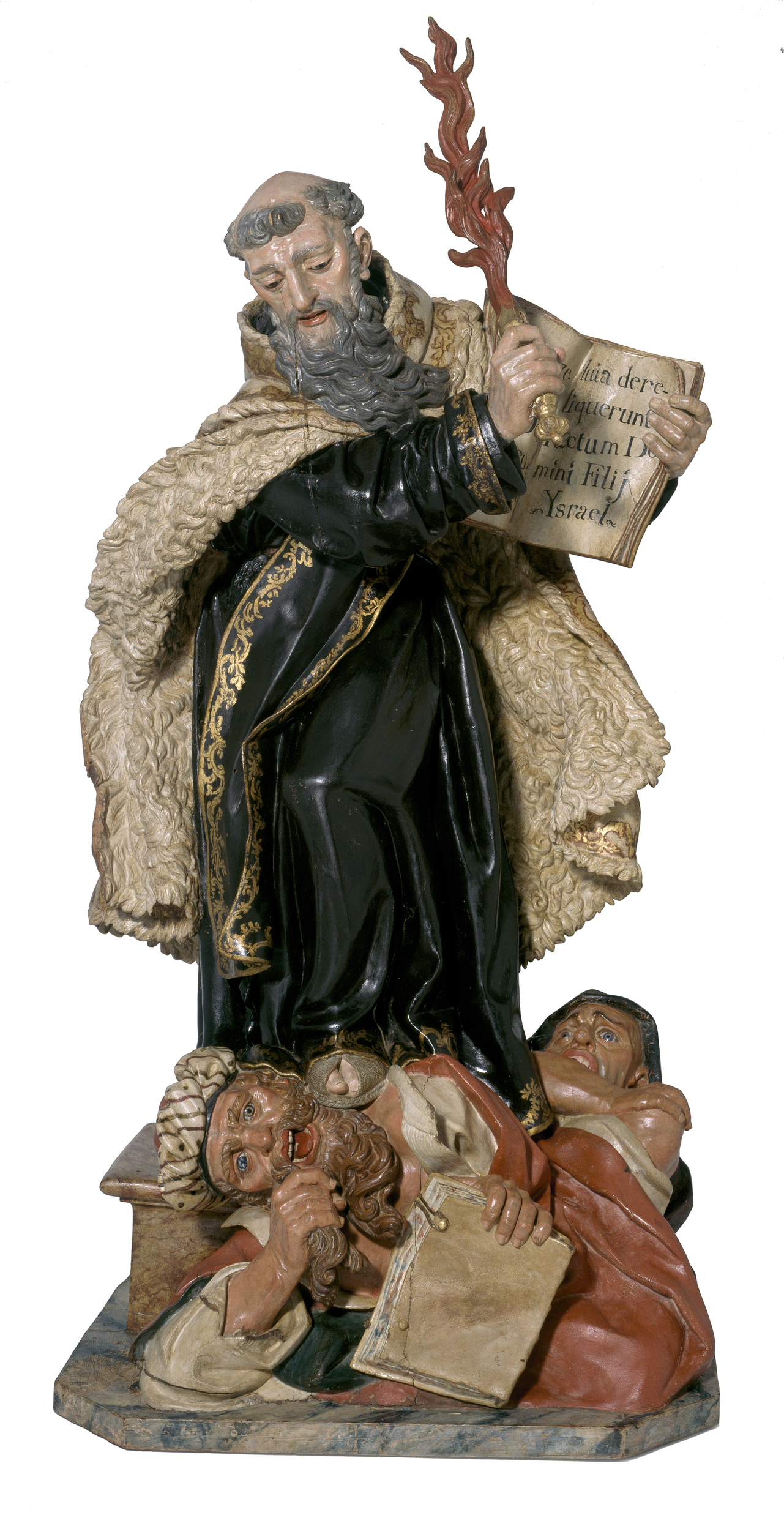
The Grand Gallery
Juan Alonso Villabrille y Ron (1663-after 1728), The Prophet Elijah, 1720s
This dramatic polychrome wood sculpture was created by 18th century Spanish Baroque artist Juan Alonso Villabrille. Carved from limewood, the work is a typical carved polychrome sculpture, also known as painted sculpture. It was a popular technique in 17th and 18th century Spain, as it allowed artists to create realistic three-dimensional representations of saints and Biblical figures, which were thought to intensify Christian devotion. The wood was usually prepared and carved by sculptors, and then artists who specialised in a technique called encarnación painted the figures.
Villabrille’s style was characterised by a sense of realism, great attention to detail, and sculptures rife with movement and tension. This work depicts the prophet Elijah, who established a community of hermits on Mount Carmel, a mountain range in northern Israel. In the Books of Kings from the Old Testament, Elijah challenges 450 prophets of Baal to a contest at the altar on Mount Carmel to determine whose deity was genuinely in control of the Kingdom of Israel. It was agreed that a bull would be offered to the gods as a gift on the altar. The God who answered with fire falling from the sky onto the offering was considered the true god. Only Elijah’s prayers were answered and the altar was flooded with fire. Villabrille captures the aftermath of this moment, where Elijah is engaged in combat against the heretics. In one hand he holds the Holy Scriptures, while in the other hand he brandishes a flaming sword. The false prophets of Baal lie in agony by his feet.
Encarnación, which literally means “incarnation” or “made into flesh” involved the careful rendering of flesh tones and features in paint. This may also be preceded by the estofado technique whereby gold and oil paint were used to imitate rich textile fabrics and textures. In order to achieve even more realistic features, real hair was used to create eyelashes, and the sculptures were brought to life with glass eyes.
- Are there any other materials you can think of that would make a sculpture even more realistic?
Explore further
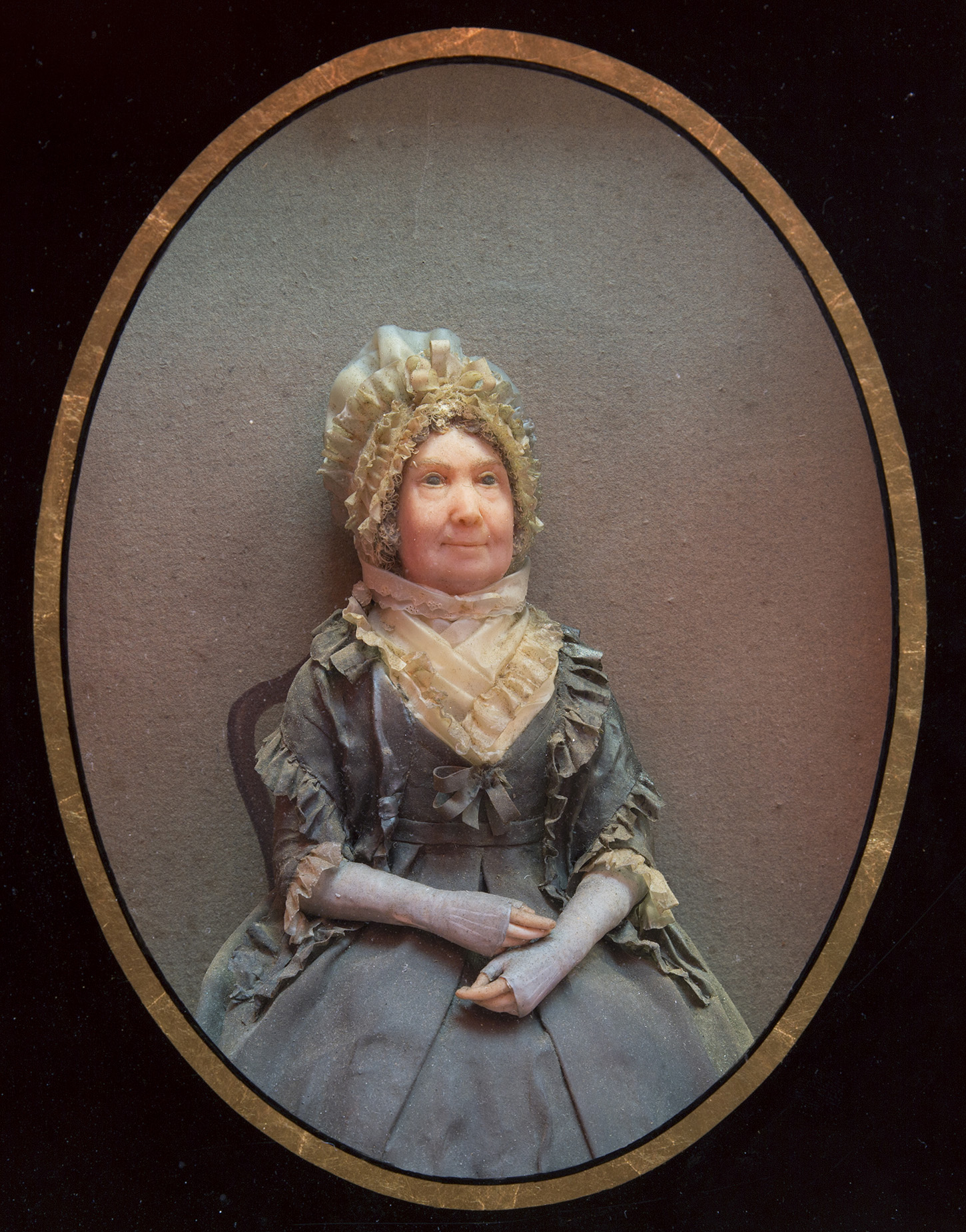
Room 47
Catherine Andras (1775 - 1860), Rosie Bruce (1728-1806), Widow of Revd. Samuel Bruce, 1799.
Catherine Andras was a self-taught wax modeller from Bristol, England. In her early twenties, Andras was adopted by the miniaturist Robert Bowyer and his wife. Andras often created wax portraits of Bowyer's sitters and showcased her impressive talent as a wax modeller. Her most famous creation is the life-size figure of Admiral Nelson at Westminster Abbey, London.
Wax has long been an important resource for artists. Due to its tactile nature and low melting point, it's very easy to manipulate and lends itself well to sculptural practices like carving, modelling, and casting. At the height of the Italian Renaissance, wax was used to create miniature relief portraits. These miniature coloured wax portraits, also known as polychromatic portraits, resembled popular antique cameo and medallion designs. A cameo is a type of carving method which involves creating a raised relief image, often on a piece of jewellery or sculptural form. A medallion is a larger panel that contains a portrait or an ornamental decoration.
Artists soon discovered that they could easily control the consistency and colour of the wax, allowing them to create various details and textures, from skin and hair, to the creation of wax textiles. The delicate polychromatic wax portrait you see here is housed in a custom-built box and portrays an elderly Mrs Rose Bruce. Originally from Co. Derry, this widow of a former Presbyterian minister in Dublin had established a comfortable life for her family in Bristol.
- What do you think of this portrait?
- If you were paying for your portrait would you have it made in wax?
Explore further
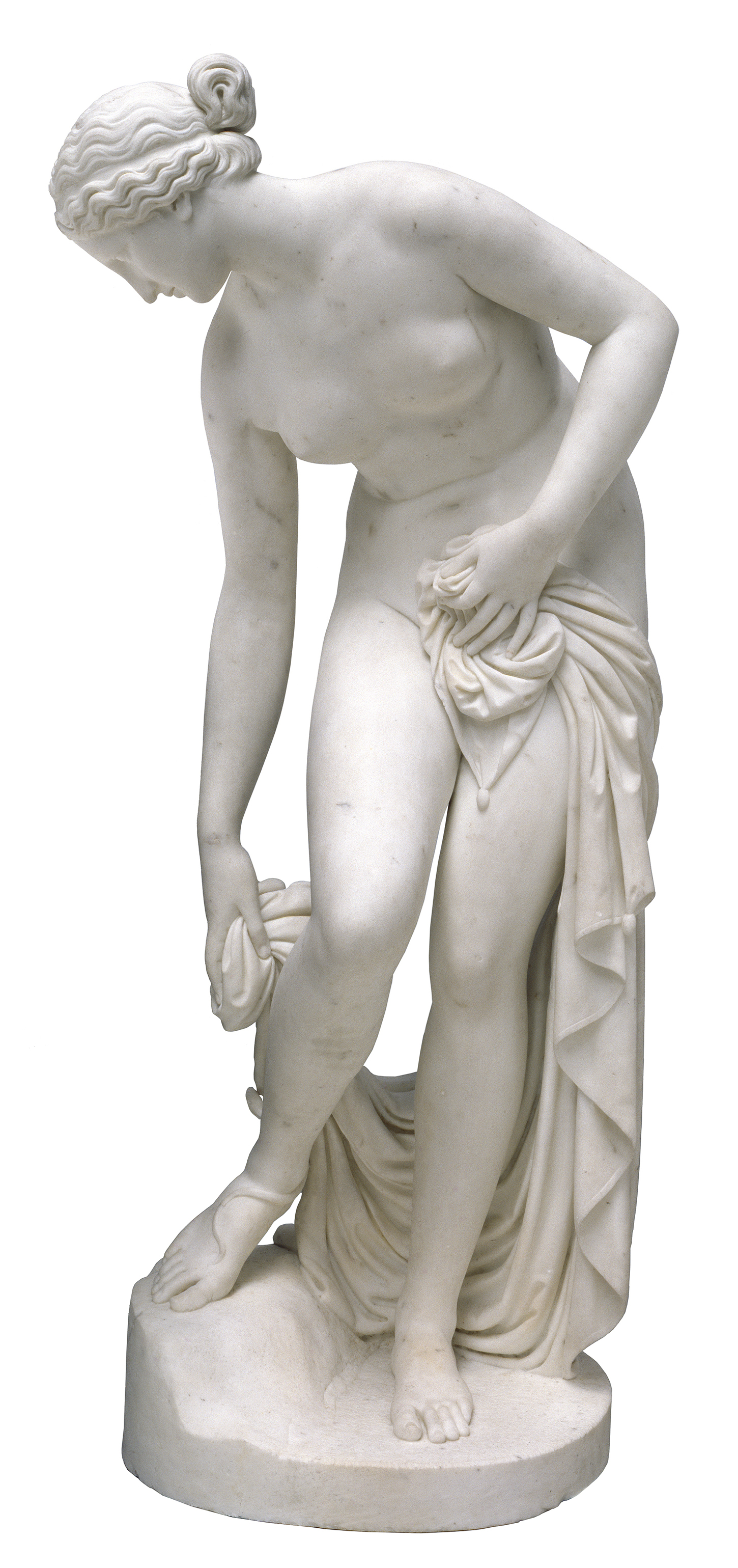
Room 46
Lawrence MacDonald (1799-1878), Eurydice, 1837
Here we see Eurydice drying herself off after bathing. Eurydice was a figure in Greek mythology. According to the myth, she received a fatal snakebite that would ultimately send her to the Underworld. She was married to Orpheus, who tried to bring her back from the dead with his enchanting music. The story of Eurydice and Orpheus is attributed to the poets Ovid and Virgil, and is one of the best-known Greek myths.
This work was commissioned by the 6th Viscount Powerscourt from the artist Lawrence MacDonald, and it was originally displayed in the first-floor saloon of Powerscourt House, Co. Wicklow beside other family portraits by MacDonald. Eurydice is fully carved on both the front and rear, to be viewed in the round. For many years, the marble sculpture remained on the upper terrace of the famous gardens. When it was eventually acquired by the Gallery, it was restored to its original state revealing the bright white marble beneath.
As a material, marble is quite porous and therefore cannot sustain long periods of handling. When it is touched, marble absorbs skin oils, which over time can lead to staining. While it is more resistant than limestone, it does not sustain well in outdoor environments which have more acidic rain.
- Have you seen marble sculpture like this in an outdoor setting?
- If so, what was your first impression of the sculpture?
Explore further
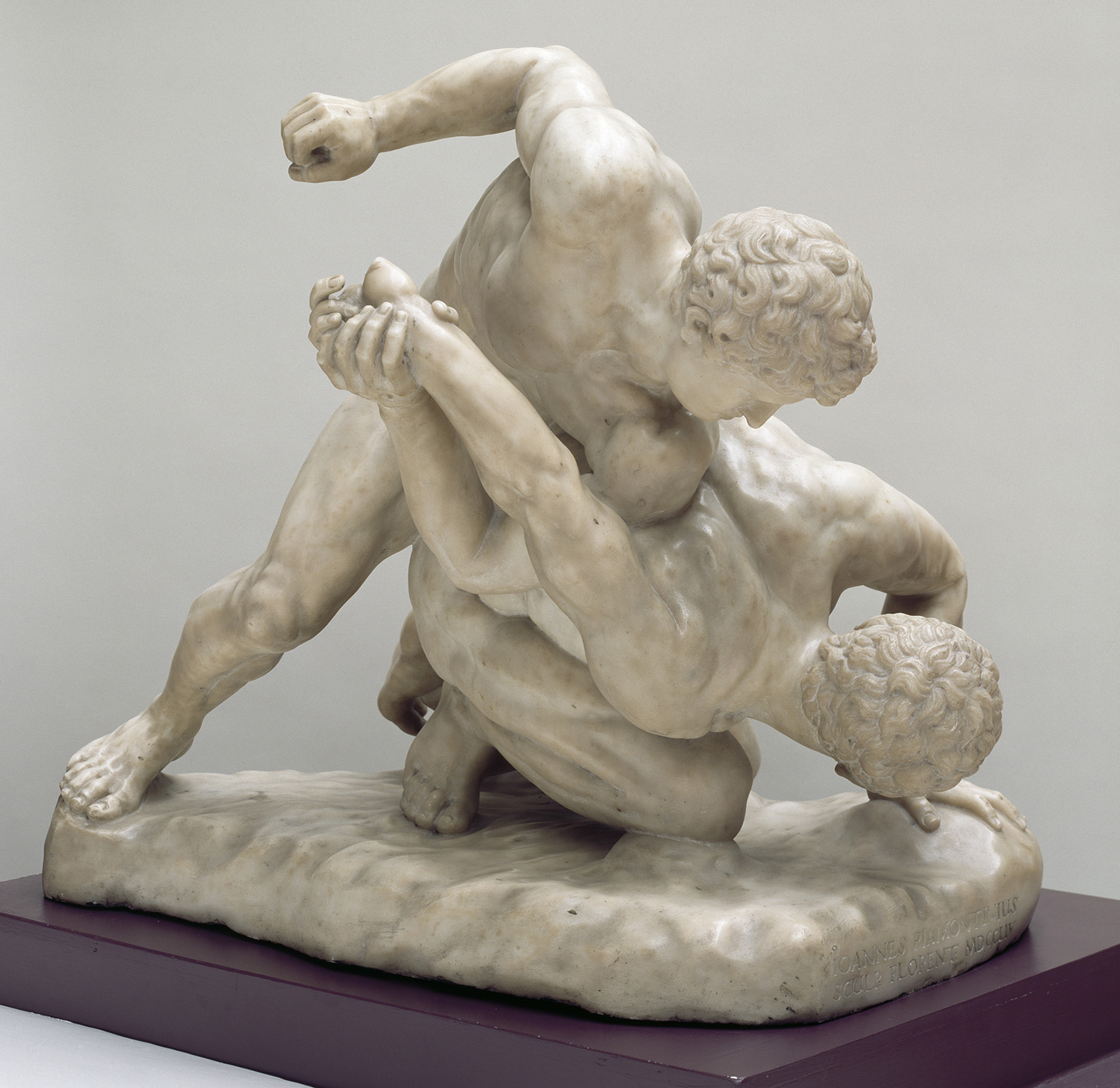
Room 46
Giovanni Battista Piamontini (fl.1725-1762), The Wrestlers, 1754
This portrayal of two naked Greek wrestlers is an 18th century copy of a sculpture discovered in Rome in 1583, which is now in the Uffizi collection, Florence, Italy. The Roman sculpture itself is in fact a copy of a Greek bronze sculpture. It can be attributed to Lysippus, a sculptor well known for many bronze and marble works and, in particular, for his portrait of Alexander the Great. The Roman version was acquired by Cardinal Ferdinando de' Medici, the Grand Duke of Tuscany from 1587 to 1609. At the age of 14 he was made a Cardinal but he was never ordained a priest.
The statue was cast many times in a variety of mediums including bronze, lead and plaster. The work was initially on display in the Uffizi Gallery in the eighteenth century, during a period when many artists were on their Grand Tour of Europe. Giovanni Battista Piamontini was one of many artists who was greatly influenced by the work. Titled The Wrestlers, it depicts Pankration, an ancient Greek sport involving a combination of wrestling and boxing. In the seventh century BCE, the sport became part of the ancient Olympic Games.
- Are there any artworks you have seen on your holidays that influenced you or stuck in your memory?
Explore further


Room 28
Ligier Richier (c.1500-1567), The Virgin and Saint John the Evangelist, 1530s
Here we see a pair of carved limewood sculptures by French artist Ligier Richier. Richier, a sculptor of religious imagery, was most notably associated with his expressive sculptural portraits of agonised religious figures. The Virgin Mary is posed clasping her hands in the contrapposto pose, the Italian term for counterpoise. The term is used to describe a figure bearing all of their weight on one foot while their body is slightly twisted or curved. Saint John can be seen gazing upwards, which would suggest that these sculptures were designed to be viewed as part of a larger group.
The use of wood in these sculptures is interesting. A large body of Richier’s work was conceived in stone so it is quite unusual to have two carved wooden sculptures. Although it's hard to tell, these wooden works were originally painted. Some traces of colour still remain visible to this day - look closely at the fabric beneath Saint John’s left arm.
Now, look to the left hand of Saint John. Do you notice anything in particular about this section? His left hand has been replaced with modern wood, most likely a form of restorative conservation. Richier was gifted at capturing fleeting emotion in his work which is evident in the burdened expressions of both figures. Although wood is quite a rigid material, he successfully captures the softness and flow of the draped fabric.
- How would you describe this artwork to someone who has never seen it before?
Explore further
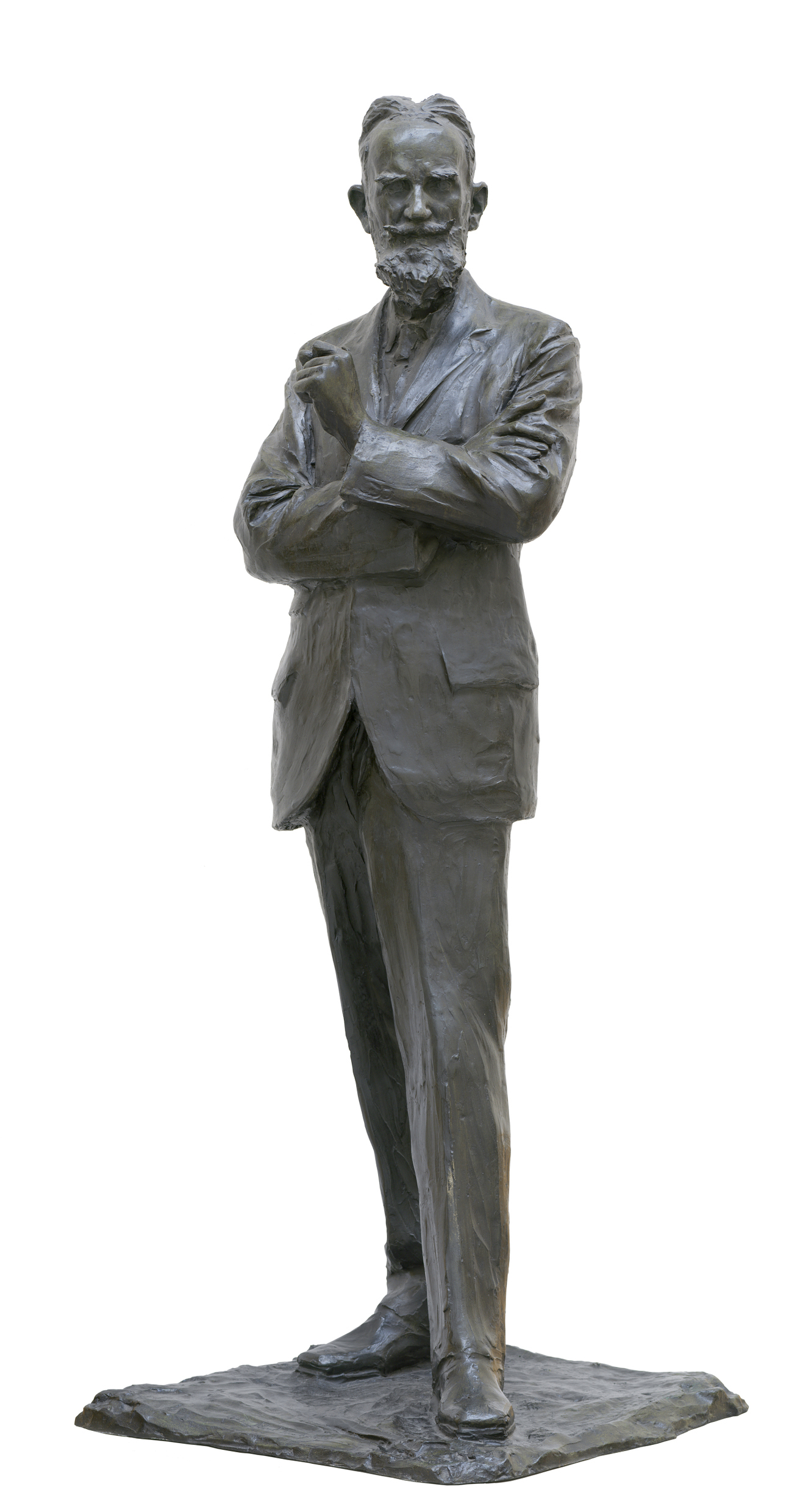 Prince Paul Troubetzkoy (1866-1938), George Bernard Shaw (1856-1950), Author, Playwright and Critic, 1927. Photo © National Gallery of Ireland.
Prince Paul Troubetzkoy (1866-1938), George Bernard Shaw (1856-1950), Author, Playwright and Critic, 1927. Photo © National Gallery of Ireland.
Millennium Wing
Prince Paul Troubetzkoy (1866-1938), George Bernard Shaw (1856-1950), Author, Playwright and Critic, 1927
This is the acclaimed author, playwright and critic, George Bernard Shaw, captured in bronze by artist Prince Paul Troubetzkoy. Shaw undertook 20 sittings (or, more accurately, 'standings'!) for this sculpture at the artist's studio on Lake Maggiore, which is divided between the Italian regions of Piedmont and Lombardy and the Swiss region of Ticino.
The sculpture is the only bronze cast that was created from the original plaster model which still survives to this day on Lake Maggiore. It was created using the lost-wax process, also known as cire-perdue. Once a mould of the original object is created, molten bronze is poured into the final mould in order to create a copy. The bronze casting technique dates back as far as 5000 BC and is still just as technically challenging.
Although captured by many artists throughout his lifetime, Shaw noted that this was one of the finest images of himself and described Troubetzkoy as ‘the most astonishing sculptor of modern times’. Troubetzkoy, the son of a Russian diplomat, was a self-taught artist who is often described as an ‘Impressionist’ due to his ability to capture movement within the medium of bronze.
- Strike a pose like Shaw’s bronze Sculpture. How does this make you feel standing in the same pose as Shaw?
- Could you stand like this for longer than 5 minutes?
Explore further
You might also like:
-

Through a Lens tour: Irish art
A self-guided tour of Irish works in our collection.
-

Through a Lens tour: Babies & Toddlers
An online self-guided tour to engage babies and toddlers
-

Through a Lens tour: Costumes in Art
A self-guided tour of works in our collection.
-

Through a Lens tour: Irish History
An online self-guided tour looking at Irish history as depicted i
